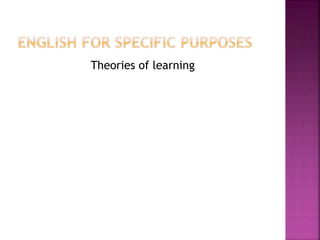
Theories of learning ppt
- 2. Give a man a fish and you feed him for a day. Teach a man how to fish and you feed him for a lifetime. (Chinese proverb) DR.M.POONKODI ASSISTANT PROFESSOR DEPARTMENT OF ENGLISH KARUNYA UNIVERSITY
- 3. Language can only be properly understood as a reflection of human thought processes i.e in understanding the structure and processes of the mind [not in the analysis of the nature of language] Language learning is conditioned by the way in which the mind observes, organises and stores information This is the key to successful language learning and teaching.
- 4. Like the development of language descriptions to see the importance of each for language teaching, it is best to consider the theories relating to language and learning separately. In the past not much theories to teach and enable learning One theory called as Direct method was used to teach until the end of 19th century
- 5. The direct method of learning English is fairly simple. In consists, primarily, of just five parts. Show – The student is shown something so that they understand the word. For example, they might be shown realia or other visual aids such as flash cards for nouns. The teacher might use gestures to explain verbs, and so on. Say – The teacher verbally presents the word or sentence, taking care to pronounce the word correctly. Try – The student then tries to repeat what the teacher is saying. Mould – The teacher corrects the students and ensures that they are pronouncing words correctly. Repeat – Finally, the students repeat the word a number of times. Here the teacher uses a number of methods for repetition, including group repetition, single student repetition and other activities designed to get the students to repeat the word.
- 6. Theories emerged only after psychology developed Pavlov (USSR)and Skinner(USA) Learning is a mechanical process of habit formation and proceeds by means of frequent reinforcement of stimulus-response sequence
- 7. Typically, the audio-lingual method includes drills and pattern repetition. There are four parts to this method. Repetition – the students repeat what the teacher says. Example: Teacher – “I walk to school”. Students – “I walk to school”. Inflection – the teacher says a word, the students say another form of one of the words back to the teacher. Example: Teacher – “I walk to school”. Students – “I walked to school”. Replacement – the teacher says a sentence and the students replace on of the words for a different word. Example: Teacher – “I walk to school”. Students – “I run to school”. Restatement - the teacher says a sentence and the students rephrase the sentence. Example: Teacher – “Tell me to walk to school”. Students – “Walk to school”.
- 8. Never translate Deal in sequence: hear, speak, read, write Repeat Correct errors immediately Basic method is pattern practice
- 9. Chomsky –against behaviourism Vague concept of generalisation Infinite range of possibilities are there so how human mind could cope with finite range of experience
- 10. Thinking as a rule -governed activity Finite ; fairly small;set of rules-no stimulus Not forming habits but forming rules Rules to form a process ; evolve an hypothesis Hypothesis is modified by subsequent experience Uses individual stimuli to find out underlying pattern of system
- 11. Use the system in a novel situation to predict, respond etc Thinking process led to cognitive theory
- 12. To learn by using rule requires thinking Apply mental powers to distil workable generative rule from the mass of data presented Analyse the situation where application would be useful and appropriate Learner I Interprets the data and learns We learn by thinking and make sense of what we see, hear and feel
- 15. 1. What is a cold blooded/warm blooded animal? 2. How does the weather affect the diffusion of gases in animals body? 3. What happens when a creature is small in a cold/hot region?
- 16. Learning is an emotional experience He must be affected with an intention to think and learn in a cognitive way. They must be motivated to read Instrumental motivation ( need) Integrative motivation (want)
- 18. Reflection of external need Need may derive from varying sources Need to pass exams Need to sell Need to speak with others Need to read texts
- 19. Derives from ones own desire Internally generated want
- 20. Learning is a conscious process Acquisition is an conscious process
- 21. Picture mind as a net work connections Individual houses, towns and villagers represent items or bundles of knowledge All these would be useful when interconnected to main networks by roads Learner’s mind is the development agency
- 23. The agency wants to develop the settlement potential Communication links must be established X could be linked only when Y and Z are connected Bridge
- 24. THANK YOU